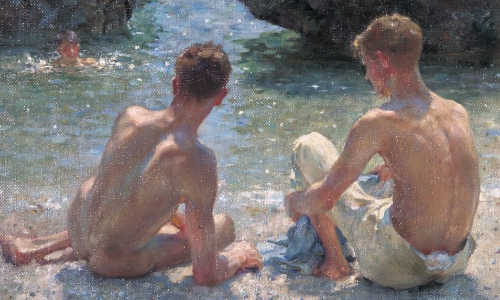Review: Queer British Art 1861-1967

The Tate Britain flew the rainbow flag to celebrate this exhibition of queer art, which marks the 50th anniversary of the 1967 act that essentially decriminalised gay sex. But while the colours fly proudly overhead, the art beneath – made in the century preceding 1967 – is an altogether more muted affair, exploring the coded desires and heartbreaking injustices meted out on generation upon generation of men and women.
The most striking piece isn’t the work of either artist or sculptor, but HM Prison Service: Oscar Wilde’s prison door. It’s an imposing, practically indestructible slab, clearly built to shackle the worst society has to offer, but put to use imprisoning a man who wrote funny stories about posh people. It’s displayed next to a full-length portrait of Wilde, slightly pudgy, wearing a familiar, arch expression. It’s impossible to reconcile the two.
Objects of interest like this are scattered throughout the exhibition: Noel Coward’s dressing gown displayed in a room examining links between gay culture and the theatre; a series of library books defaced by Joe Orton and Kenneth Halliwell, who plastered the covers with mischievous collages before returning them to the shelves, earning them both six months in prison. These pieces give the exhibition a museum-like quality: contemplative, full of surprising snippets.
Presented in roughly chronological order, we’re first met with a room full of classically-inspired paintings, a form in which it was relatively acceptable to depict naked men or women together. Some are openly homoerotic, while others bear more subtle queer messages: in Walter Crane’s The Renaissance of Venus, for example, “Venus” was modelled on a bloke called Alessandro, with Crane adding a pair of breasts later. “She was a fine, upstanding slip of a boy,” he mused.
Others, meanwhile, are rather more in-your-face – in William Blake Richmond’s The Bowlers (1870), a group of “women” are painted as boys in dresses, while in the foreground two naked men stand one behind the other, the first bending over to throw a ball. You don’t have to squint hard to see them doing it.
This piece is perhaps most notable for the reaction when it was first displayed: nobody seemed to notice the homoeroticism. It says something about how thoroughly gay culture was banished from gentile society that this could ever have seemed like an innocent game of boules.
Elsewhere highlights include a wonderfully varied series of paintings by Duncan Grant: the delicate impressionist strokes of Bathers by the Pond; the heavy oils used to depict his sometime lover PC Harry Daley; the modernist lines of Bathing, with its exaggerated pecs and bums bobbing in the Serpentine.
Further in there are several early Hockneys – prised away from the exhibition upstairs – hung in the same room as paintings by Francis Bacon. The two show a dichotomy in queer culture, Hockney’s works full of excitement and the promise of pleasures to come, Bacon’s deep black and red, filled with twisted, bulging lines, suggesting pain, anguish and isolation.
There’s a commendable restraint in this hang, a desire to explore rather than impress, to probe not shock (I wonder how different it might have been had the Tate Modern hosted it, rather than it’s more austere sibling). It’s thoughtful and sad and funny and touching, a portrait of exceptional people under exceptional pressure producing exceptional work.
First published in City A.M.

